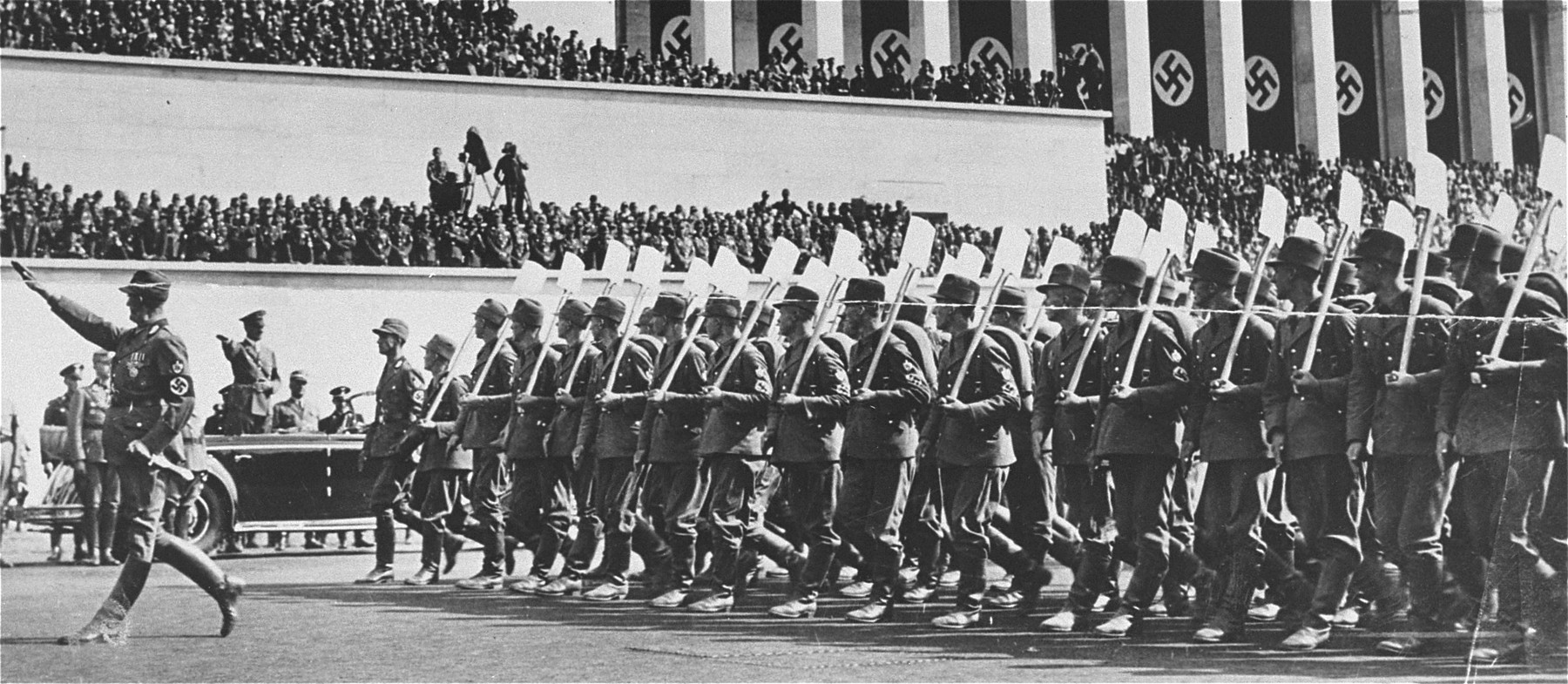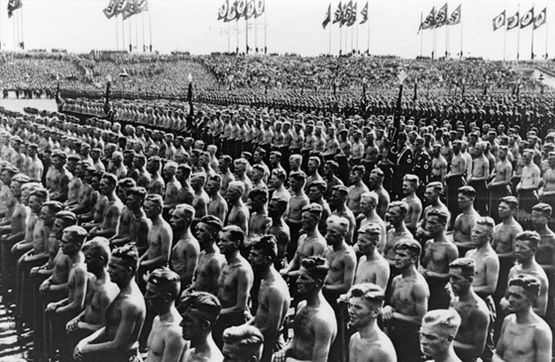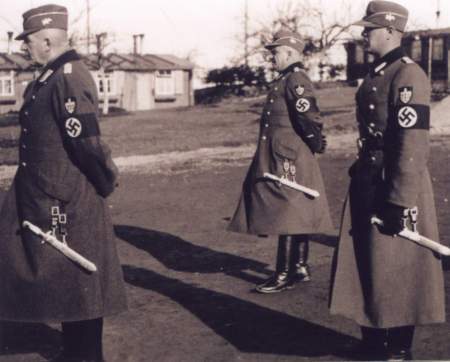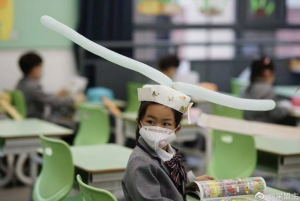This article featuring topless Nazis with very big tools was written by the team over at Reaper Feed. Check them out for the latest on military history, dark stories and battlefield weapons and technology.
Prior to the outbreak of WW2, Nazi Germany had long been planning the militarization of the country through a variety of schemes and organizations. The National Socialist Flyers Corps, for example, was a cunning way to train the Luftwaffe without breaking the Treaty of Versailles in the 1930s. One organization, known as Reichsarbeitsdienst or The Reich Labour Service, was established to provide work for the nation and rebuilt the country whilst simultaneously militarizing and indoctrinating millions of, primarily fight age male, Germans. Abbreviated as RAD, it became the official labour service of the Nazi state and would go on to construct the Autobahn.
The RAD, however, was not originally a Nazi idea. Throughout Europe during the Great Depression, there were many similar organizations that existed to try and provide people with much-needed employment and a purpose. Germany was no exception and home to various similar organizations. However, the original RAD program was proposed under the Weimar Republic two years before the Nazis came to power. Its original name was the voluntary labour service or Freiwilliger Arbeitsdienst (FAD). It was intended to serve as assistance to land and civic improvements throughout Germany. Under the Weimar Republic, this was a voluntary organization and headed by Reichskommissar Friedrich Syrup.
As the Nazis took power in 1933, they were keen to reinvent the FAD, and it was renamed the National Socialist Labour Service, or Nationalsozialistischer Arbeitsdienst abbreviated as NSAD. Friedrich Syrup.was sacked by Hitler, and replaced with a high ranking member of the Nazi Party: Konstantin Hierl. Under the rule of Hierl, the labour service was reinvented, and he wanted to make sure it was no longer voluntary, but that it was compulsory to join. However, the voluntary aspect was a method to avoid breaching the Treaty of Versailles following WW1, and following an outcry from the Geneva World Disarmament Conference, it was forced to remain voluntary, for now.
In 1934, the Nazis renamed the NSAD to Reichsarbeitsdienst abbreviated as RAD. Konstantin Hierl would remain as its leader until his death in an NKVD camp after WW2. By 1935, the Nazis were not listening to the Treaty of Versailles, and a new law was introduced that the RAD would now incorporate the various German labour organisations that were formed during the Weimar Republic. The Nazi government soon began pumping millions in funds to the organization, whose initial role was to provide assistance and services to military projects rather than civic and agricultural construction projects.
As the Treaty of Versailles faded evermore into insignificance, the RAD was made compulsory once again, and nobody spoke out to stop it. The Reich Labor Service Act of June 26, 1935, declared, ” The Reich Labor Service is an honorary service to the German people. All young Germans of both sexes are obliged to serve their people in the Reich Labor Service. The Reich Labor Service is to educate the German youth in the spirit of National Socialism to the national community and to the true working attitude, above all, to the due respect of manual labor. The Reich Labor Service is intended for the performance of charitable work.” Thus, the militarization of a new generation of Germans had begun.
Once conscripted for the RAD, new members were sent to gender-segregated labour barracks around the country. The RAD was composed of 33 work districts, each headed by a commanding officer with headquarters staff and a guard company. Most districts featured up to 8 work labour divisions of up to 1,800 men or women, and the workweek was around 76 hours of tough labour.
Upon entry to the RAD, its members were issued with a bicycle and a spade alongside a classic paramilitary uniform of the Third Riech. Next to the Nazi armband, the uniform featured the symbol of the RAD, which was an upward-pointing shovel bearing the swastika. On top of this, all eligible men were issued with a RAD Hewer, a formidable ceremonial dagger that symbolized a labour tool. Following WW2, many of these ornate daggers were shipped to South America, where they were used for chopping down sugar cane.
As WW2 erupted in 1939, the RAD was almost immediately classed as Auxiliary support forces alongside the German military. Initially, they were not part of the army but would provide much-needed support and be afforded some form of protection by the Geneva Convention. During the Blitzkrieg into Western Europe, thousands of RAD members followed behind the German forces and played vital roles supplying food and ammunition to the frontline. They would repair roads that had been bombed or crushed under columns of German tanks as well as carry out construction on airfields for the Luftwaffe. In France, they would go on to play a huge role in the construction of the Atlantic Wall.
As the war went on and German resources became stretched, the tasks of the RAD became more varied as they started to lay minefields and man fortifications. As the war turned dire for Germany, the RAD were soon pulled into combat and started to man Flak Batteries and filled combat roles on the dreaded eastern front, replacing the scores of German infantry who had been killed.
By 1944, as the Allies and the Russians closed in on opposite fronts, most of what was left of the men and women of the RAD were formed into 6 frontline units and soon engaged in serious combat on the Western and Eastern Fronts. During the attack on Arnhem Bridge in Operation Market Garden, the RAD were drafted in to reinforce the Waffen SS. However, with almost no combat experience and pitted against the ferocious soldiers of the British Parachute Regiment, the RAD were shot down in their hundreds. In 1945, alongside a ragtag group of old men, children and women, the RAD were pulled into the Volkssturm and pitted in the futile fight against the overwhelming forces of the Red Army in Berlin.
With Hitler dead and Germany in ruins, the RAD died in the ashes of Berlin. During the final months of the war, whilst his men and women were dying in gruelling fights that could not be won, the RAD commander Konstantin Hierl was awarded the highest decoration the Nazi Party could bestow on an individual, known as the German Order. Following the war, Hierl was put on trial and sentenced to five years in a labour camp. He was released and died in 1955.




